Gudeodiscus messageri
| Gudeodiscus messageri | |
|---|---|
 | |
| Gudeodiscus messageri raheemi | |
| Scientific classification | |
| Kingdom: | Animalia |
| Phylum: | Mollusca |
| Class: | Gastropoda |
| (unranked): | clade Heterobranchia
clade Euthyneura |
| Superfamily: | Plectopyloidea |
| Family: | Plectopylidae |
| Genus: | Gudeodiscus |
| Subgenus: | Gudeodiscus |
| Species: | G. messageri |
| Binomial name | |
| Gudeodiscus messageri (Gude, 1909)[1] | |
| Synonyms[2] | |
|
Plectopylis messageri Gude, 1909 | |
Gudeodiscus messageri is a species of air-breathing land snail, a terrestrial pulmonate gastropod mollusk in the family Plectopylidae.
Subspecies
Gudeodiscus messageri include two subspecies:
- Gudeodiscus messageri messageri (Gude, 1909)
- Gudeodiscus messageri raheemi Páll-Gergely & Hunyadi, 2015[2]
Distribution

The distribution of Gudeodiscus messageri messageri is known from Vietnam along the Chinese border (Yunnan Province).[2]
The distribution of Gudeodiscus messageri raheemi is known from Vietnam from Ninh Bình Province, Thanh Hóa Province, Sơn La Province, Hòa Bình Province and Nghệ An Province[2] and from Luang Prabang Province in north Laos and Vientiane Province in northwest Laos.[3] Gudeodiscus messageri raheemi in Laos is the westernmost record of the genus Gudeodiscus.[3]
Description
The shell of Gudeodiscus messageri is small to medium-sized, with slightly elevated spire.[2] The dorsal surface is somewhat domed.[2] The aperture is almost circular.[2] The apertural fold is missing.[2] Callus is rather blunt and only slightly curved.[2] Parietal wall has two lamellae (the anterior lamella may be dissolved into small denticles).[2] Lower parietal plica is free or connected to the anterior lamella.[2] Palatal plicae are oblique, or depressed Z-shaped, usually in contact with each other.[2]
Gudeodiscus messageri messageri
The most important shell characters for identification of Gudeodiscus messageri messageri include: slightly elevated spire, callus is not angled in the middle, apertural fold is always missing.[2] Other characteristics include: anterior lamella is normal (it is not dissolved into small denticles).[2] Lower parietal plica does not extend beyond the anterior lamella in the anterior direction.[2] The width of the shell is 12.75–18.5 mm.[2]
Views of the shell of Gudeodiscus messageri messageri by Gerard Pierre Laurent Kalshoven Gude:
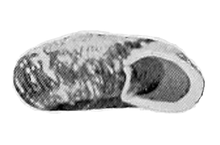 Apertural view. |
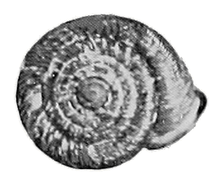 Apical view. |
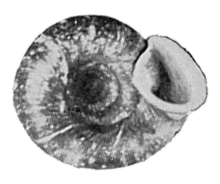 Umbilical view. |
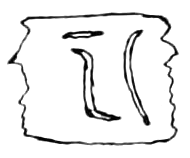 Drawing of parietal plication of Gudeodiscus messageri messageri. |
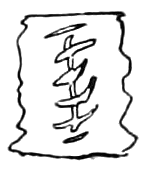 Drawing of palatal plication of Gudeodiscus messageri messageri. |
Gudeodiscus messageri raheemi
The most important shell characters for identification of Gudeodiscus messageri raheemi include: body whorl is less shouldered than that of the nominotypical subspecies, but plicae have to be observed for correct identification.[2]
Views of the shell of Gudeodiscus messageri raheemi:
 Apertural view. Scale bar is 20 mm. |
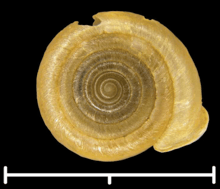 Apical view. |
 Umbilical view. |
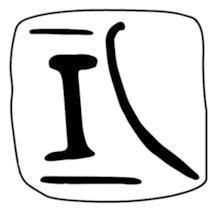 Drawing of parietal plication of Gudeodiscus messageri raheemi. |
 Drawing of palatal plication of Gudeodiscus messageri raheemi. |
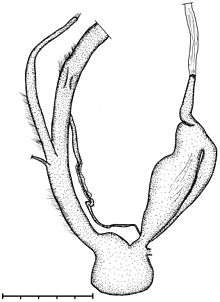
The radula of Gudeodiscus messageri raheemi has 8 lateral teeth and 16 marginal teeth.[2] The size of the central tooth is as large as or larger than the ectocone of the first lateral.[2] The shape of the first lateral is rhomboid and pointed.[2] Marginal teeth are tricuspid with rather sharp inner cusp and deep incision between the cusps.[2]
Embryos were recorded to be present in the uterus.[2] There were not recorded calcareous granules on the internal surface of penis.[2]
Ecology
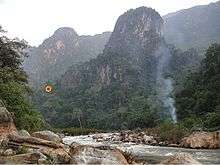
It is a ground-dwelling species as all other plectopylid snails in Vietnam.[2] It lives in primary forests and in old secondary broad-leaved forests.[3] It can be found in the humid microenvironments under leaves, logs, limestone rocks and in black soil accumulated inside limestone pockets.[3]
It co-occur with other plectopylids in Vietnam: with Gudeodiscus phlyarius and with Gudeodiscus hemmeni.[2] It also co-occur with clausiliid Garnieria mouhoti, that is also associated with the moderate humidity of broad-leaved forests.[3]
References
This article incorporates Creative Commons (CC-BY-4.0) text from the references[2][3]
- ↑ Gude G. K. (1909). "Descriptions of six new species of Plectopylis from Tonkin". Proceedings of the Malacological Society of London 8(4): 213–218. pages 214-215, plate 9, Figs 3, 3a–b.
- 1 2 3 4 5 6 7 8 9 10 11 12 13 14 15 16 17 18 19 20 21 22 23 24 25 26 Páll-Gergely B., Hunyadi A., Ablett J., Luong Van H., Naggs F. & Asami T. (2015). "Systematics of the family Plectopylidae in Vietnam with additional information on Chinese taxa (Gastropoda, Pulmonata, Stylommatophora)". ZooKeys 473: 1–118. doi:10.3897/zookeys.473.8659.
- 1 2 3 4 5 6 Páll-Gergely B., Muratov I. V. & Asami T. (2016). "The family Plectopylidae (Gastropoda, Pulmonata) in Laos with the description of two new genera and a new species". ZooKeys 592: 1-26. doi:10.3897/zookeys.592.8118.